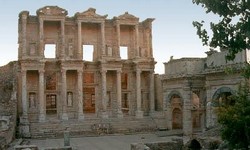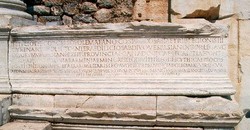Library of Celsus, Tomb of the Governor of Asia Minor
Library of Celsus, an example of Roman architecture with Greek influence in style
The ancient city of Ephesus that is an hour away from İzmir (Smyrna) is the most well known archaeological site of Turkey. It is on the way between İzmir and Aydın and can be reached on the exit of Selçuk. The site is within walking distance from the center of Selçuk. Tourists of almost all destinations on the Turkish riviera have the possibility to find a daily tour to Ephesus site.
 One of the most important attractions in the
ancient city is the Library of Celsus, built in AD 135 by Gaius
Julius Aquila (a consul) to honor his father’s memory, Tiberius
Julius Celsus Polemaeanus the Governor of Asia Minor. The building
was intended to be used both as Library and as the tomb of his
father.
One of the most important attractions in the
ancient city is the Library of Celsus, built in AD 135 by Gaius
Julius Aquila (a consul) to honor his father’s memory, Tiberius
Julius Celsus Polemaeanus the Governor of Asia Minor. The building
was intended to be used both as Library and as the tomb of his
father.
The Library was to house 12,000 scrolls, and as a tomb for Celsus, which was a great and special honor at that time as it was unusual for someone to be buried within a library or even within city limits of the time.
The building is one of the few remaining examples of Roman influenced libraries and is important because it is evidence that public libraries were being built all over the empire and not only in Rome. The front facade has been restored after a massive project and work and is now a prime example of the Roman architecture for public buildings.
 The library houses a single hall that faces
eastwards to benefit from the morning sun. The entrance is reached
trough nine steps laying end to end in the front and
there are three entrances to the hall and the one in the middle is
taller and wider then the other two. On each side of the stairs
Celsus’ life is described in Greek and Latin writings.
The library houses a single hall that faces
eastwards to benefit from the morning sun. The entrance is reached
trough nine steps laying end to end in the front and
there are three entrances to the hall and the one in the middle is
taller and wider then the other two. On each side of the stairs
Celsus’ life is described in Greek and Latin writings.
The entrance is in the form of a two colonnaded building with
triangular pediments on their top. The first storey is Ionic in
order while the second is in Corinthian order. There
are niches in between the columns which serve as stands for various
statues that symbolize the virtues of Celsus: Sophia
(wisdom), Episteme (science), Ennoia (intelligence),
and Arete (excellence). The facade looks very similar to
the stage building behind the orchestra in ancient Greek theaters.
So the style is of Roman architecture with Greek influence.

The inside of the building hasn’t been restored completely. There are no other windows apart the front side because the library was surrounded by other buildings. The large hall is believed to be of three levels housing the 12,000 scrolls which were accessed through stairs built into the walls. At the back wall there is an apses where it assumed that there was a statue of either Celsus or Athena and Celsus’ tomb was below the statue in a vaulted chamber. The ceiling was probably flat with a square opening in the center to provide for extra light to the visitors.
February 9, 2009
